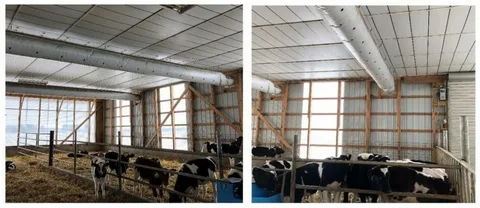
The successful production of dairy or livestock business is built upon healthy rearing of calves, yet the success rate of these animals can be ruined by the poor conditions of the barns. Young animals are especially susceptible to environmental stresses and, therefore, it is highly important to ensure the optimal air quality. Adequate ventilation of the barn is essential in the health and development of cows since it lessens respiratory illnesses, alleviates unease, reduces anxiety, and encourages excellent weight gain. The major part of ensuring such outcomes is played by industrial ceiling fans (HVLS in particular) that keep the air on the move, decrease humidity, and distribute the contaminants. This can revolutionize barn management to dairy farmers, livestock managers and veterinary advisors. RTFANS has more than 20 years of experience in ventilation solutions and, therefore, has observed the impact of fans on improving the performance of calfs. Now we can go further to understand why calves are prone, effects of bad ventilation, the support of airflow to grow, the use of ceiling fans, a case study and frequently asked questions.
Why Calves Are Vulnerable
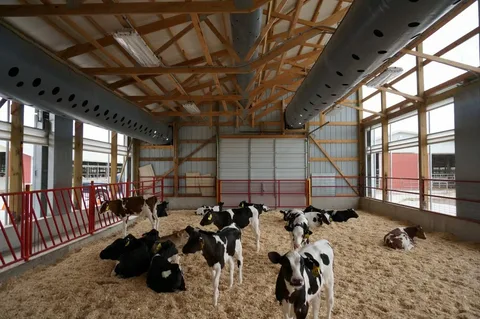
The calves are highly vulnerable to environmental influences such as temperature variation, humidity, and airborne pathogens at least during the first few months of their life as they still have immature immune systems. Their respiratory systems are under-developed and all this exposes them to danger of infections such as pneumonia with mortality rates of 5-15 in poorly ventilated barns. Temperature exceeding 68 o C (20 o C) slows down growth by a 10-20 percent decrease in feed intake. A humidity of more than 60% promotes the growth of bacteria which worsens the scours (diarrhea), which is the major cause of calf losses. The above vulnerabilities prove the necessity to provide the airflow in calf health barns to ensure the stable and clean environment.
Impact of Poor Ventilation on Calf Health
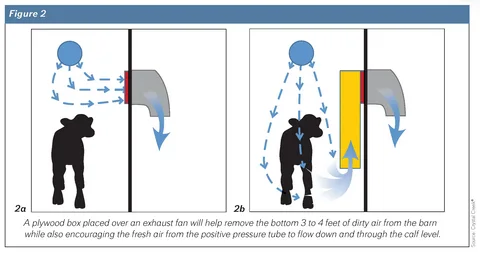
Lack of proper ventilation in barns stagnates the air, increases humidity and accumulation of contaminations, which have a direct negative impact on calf health and economic performance of farms.
Higher Risk of Respiratory Diseases
The stagnant air traps ammonia in manure and CO 2 in respiration, which are beyond the safe limit (ammonia more than 10 ppm causes irritation). Research has indicated that poor ventilation raises the occurrence of pneumonia by 20-30 percent, one of the killer diseases in calves. The respiratory problems lower the growth rates by 15% since the energy is channeled on combating infections.
Slower Weight Gain and Reduced Feed Efficiency
Poor airflow causes heat stress which decreases feed intake by 5-10% of the hourly gain by one degree, and decreases daily weight gain by 10-25%. In dairy calves, this slows the weaning and first lactation decreasing the lifetime productivity by 5-10%. The same can be said of Poultry and beef calves in which they end up losing money through low market weight.
Greater Veterinary Costs and Mortality
Lack of ventilation leads to a 5-10 percent rise in mortality and the cost of treatment is raised to $100300/calf. The farms record 15-20 percent more costs on preventable illness, which burdens budgets.
How Proper Airflow Supports Growth
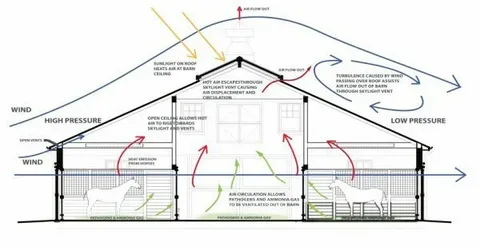
Good ventilation ensures maximum growth of the calf as it fits the animal welfare requirements.
Consistent Air Mixing Prevents Hot/Cold Spots
Correct air circulation keeps temperatures between 50-68 o F (10-20 o C) and humidity under 60 which avoids stress. Fans provide uniform distribution of temperature, which is 5-10o C less and helps maintain constant growth.
Removes Moisture and Contaminants
The ammonia and pathogens are diluted by airflow 15-20 and reduce risks of infection. Research indicates that ventilated barns prevent scours by a quarter to improve survival and growth.
Reduces Heat Stress, Improving Feed Intake and Growth
Lower temperatures increase the rate of feed consumption by 10-15 percent, increasing the rate of weight gain by 0.5-1 pound per day. This justifies the importance of airflow on calf growth and 10-20% improved feed efficiency has been reported in farms.
Role of Industrial Ceiling Fans
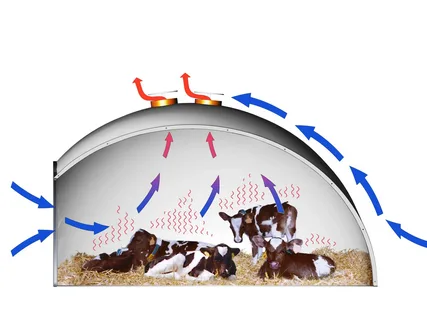
HVLS ceiling fans suit large-scale air movement, calf barns are the best place to use them since they do not create drafts.
HVLS Fans Improve Air Distribution
HVLS fans with 8-24 feet come with a 10,000-22,000 square feet of coverage in a single unit, which is adequate to provide even distribution of air in calf pens. They lower the humidity by 10-15% minimizing molds and bacteria.
Quiet Operation Reduces Stress
Working at a minimum of 35 dB, HVLS fans do not frighten young calves as noisy traditional fans (50-60 dB) do. This favors animal welfare airflow barns, which reduce stress hormones that obstruct growth.
Energy-Efficient Compared to Heavy HVAC
HVLS fans consume less than 1.5 kW, and HVAC is 20-30 less expensive. They supplement hybrid ventilation systems, which will save $2,000- 5,000 per year in small barns.

Case Scenario: A Dairy Farm’s Success
In a dairy farm of 50 cows located in Midwest, 15% of the calves died as a result of respiratory problems that were caused by inadequate ventilation. During the summer season, temperatures were sometimes over 80°F (27C) which decreased the weight gain by 20 percent. The calf barn ventilation solutions using two 16-foot HVLS fans reduced the humidity by 12 percent and the temperatures by 8 F. Death rates went down to 5, the milk production in mature cows (because of healthier calves) was up by 10, and the expenditure to the veterinary became 3,000 a year less. This indicates that HVLS fans enhance the health of calf in actual farms.
FAQ: Common Questions About Barn Airflow for Calves
- Do ceiling fans spread pathogens in calf barns?
No, According to animal science studies, HVLS fans reduce the risk of infection by 15-20% by diluting contaminants, as well as by providing the correct design of the barn. - What’s the ideal airflow rate for young livestock?
Barn ventilation calves should be provided with 100-200 cubic feet per minute per calf; this will ensure that they are not stagnant but at the same time avoid drafts. - How do fans improve weight gain in calves?
Fans help to increase feed consumption by 10-15 percent by lowering heat stress resulting in 0.5-1 pound daily gain, demonstrated in livestock research. - Can poor airflow cause long-term issues in calves?
Yes, it predisposes respiratory diseases by 20-30 times, retards growth and increases mortality, and costs the economy $100-300 per calf.
Conclusion
Unventilated barns lead to respiratory diseases, retarded growth, and increased costs whereas correct airflow improves the health of calves. HVLS fans are effective in terms of airflow in calf health barns through lowering humidity and stress. The integration of industrial ceiling fans in calf barns should be included by farmers as a low-cost and high-impact option to healthier livestock. RTFANS is a 20+ years old specialized HVLS provider. Today contact us to better ventilate your barn, your future calves will be dependent on this.
